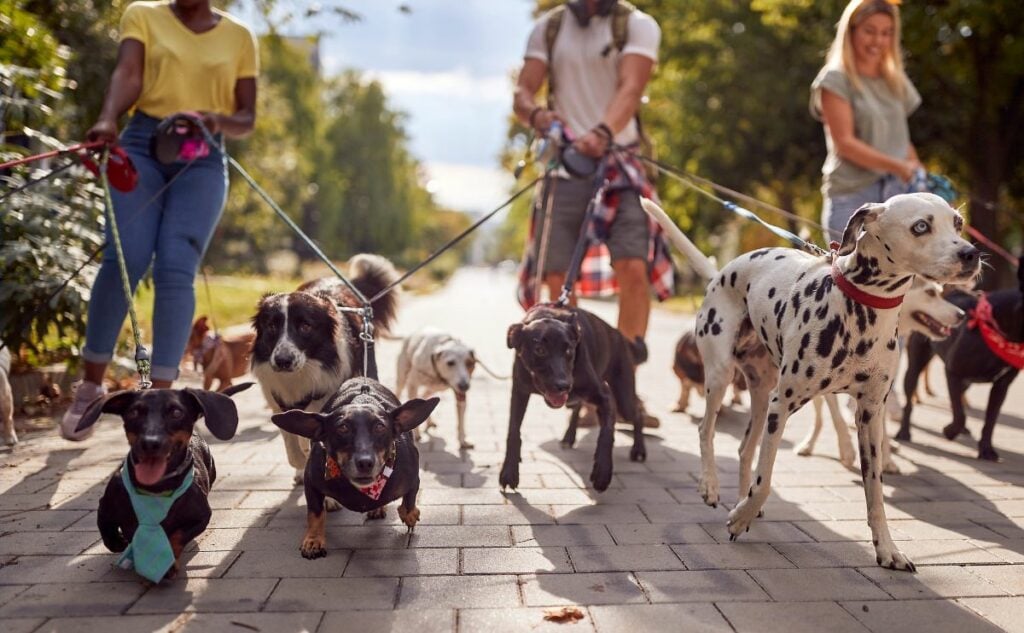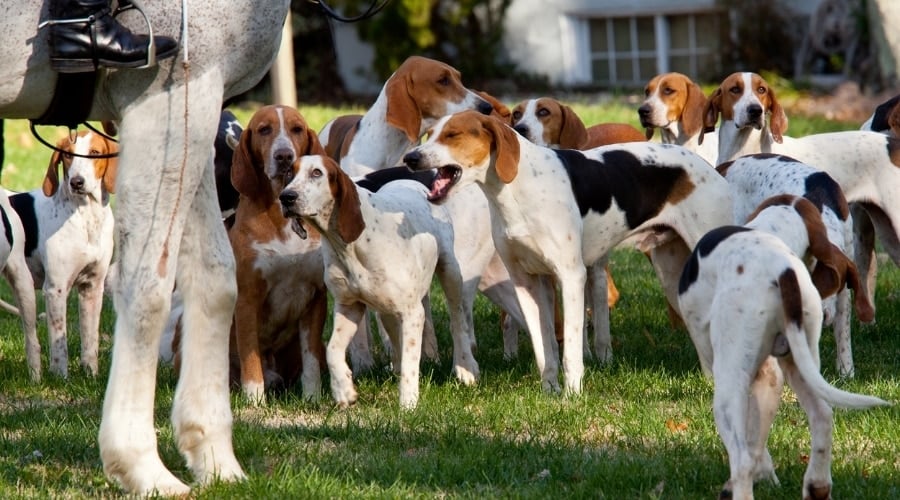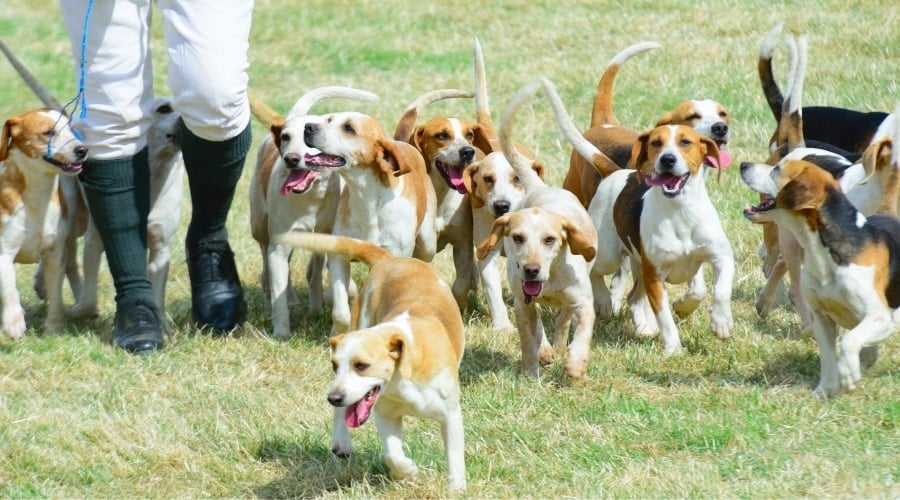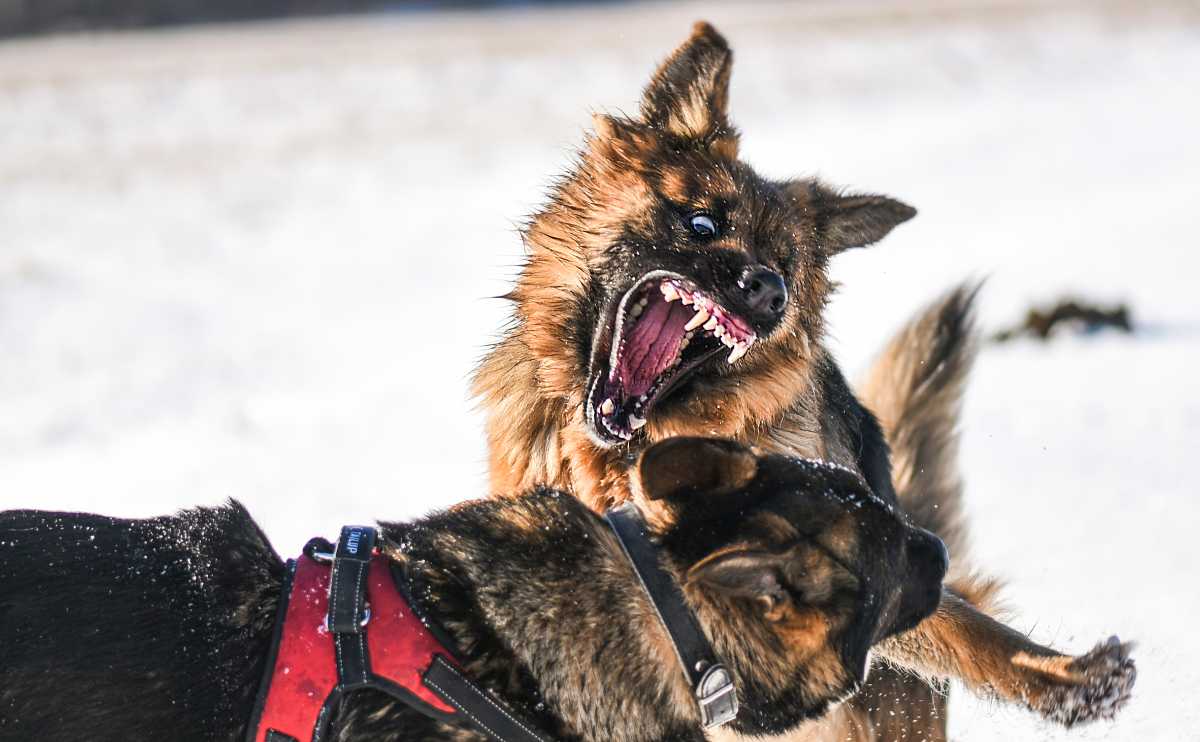STOP Trying To Be The Alpha! The Truth About Dog Pack Behavior
When you purchase through links on our site, we may earn a commission. Here’s how it works.
You’re not alone if you’ve ever been told you need to be the alpha dog in your household to keep your pup in check. For years, dog owners were led to believe that dominance theory in dogs meant they had to assert control. Eating before their dog, walking through doors first, or even rolling their pup onto its back in an “alpha roll.” Sound familiar?
Table of Contents

Well, here’s the thing: modern science has completely debunked the alpha dog myth. The idea that our furry friends are constantly plotting a power struggle to take over the house? Yeah, that’s outdated thinking. Dogs aren’t trying to dominate their owners. They’re just looking for guidance, consistency, and positive reinforcement.
So, what’s the truth about dog pack behavior? Do dogs really see humans as part of their pack? And if the alpha leader idea isn’t real, what’s the best way to train your dog? We’re diving into the latest science-backed research to bust the myths, unravel the facts, and show you the best dog training methods that actually work. All without intimidation or outdated dominance techniques. So, let’s set the record straight and give you the tools to train smarter, not harder!
Dog Pack Behavior: What Science Says Today
So, how has our understanding of wolf and dog pack behavior changed? For years, dog owners have been told that their pups are pack animals that need a strong alpha leader to keep them in line. The idea is simple: if you don’t establish yourself as the boss, your dog will try to dominate you.

But here’s the truth: modern science has completely debunked this outdated dominance theory. So, where did this whole “alpha dog myth” come from? And what do we actually know about how dogs behave in a pack? Let’s break it down.
How Our Understanding Of Dog Hierarchy Has Changed
The idea that dogs follow a pack hierarchy with a dominant alpha leader is rooted in research conducted back in the 1930s and 1940s. Swiss animal behaviorist Rudolph Schenkel observed the behavior of unrelated wolves in captivity and concluded that wolves fight for dominance in a pack, resulting in a clear leader.
His study and scholarly literature by other animal behaviorists, most notably David Mech, gave rise to dominance theory and alpha theory, which were applied to wild wolves and eventually to dogs and human-dog relationships.
Researchers observed wolves in captivity and noticed constant power struggles, with a single dominant “alpha” ruling over the pack. Naturally, people assumed that since dogs descended from wolves, they must behave the same way.
But there was one HUGE problem with these studies. The wolves being studied weren’t in their natural environment. They were unrelated wolves, forced to live together, which is like studying human behavior by locking strangers in a house and watching them fight for control. It’s not exactly an accurate reflection of real life, right? So, after decades of wild wolf pack research, experts, including Mech, have debunked the theory of alpha male.
As Mech asserted in his 1999 published study, Alpha Status, Dominance, and Division of Labor in Wolf Packs:
Attempting to apply information about the behavior of assemblages of unrelated captive wolves to the familial structure of natural packs has resulted in considerable confusion. Such an approach is analogous to trying to draw inferences about human family dynamics by studying humans in refugee camps. The concept of the alpha wolf as a ‘top dog’ ruling a group of similar-aged compatriots is particularly misleading.
What We Now Know About The Alpha Dog Myth
We now know that most wild wolf packs consist of a breeding pair and their offspring. In the wild, wolves don’t form strict dominance hierarchies. Instead, they function as family units, with parents (not “alphas”) naturally leading their offspring. There is no single pack leader, and the parents don’t exhibit dominant hierarchy-based behavior toward each other or their offspring. When offspring reach one to three years old, they leave the pack to start their families. They don’t compete for dominance over their existing pack.

It’s also important to point out the general problem of applying wolf behavior to that of domestic dogs. Dogs aren’t wolves, and most don’t live with other dogs in familial groups or large packs. Sure, they share some genetic history, but domestication has completely changed how dogs behave. Unlike wolves, dogs have evolved to be social companions to humans. Their behavior is shaped more by human interaction than by any so-called pack hierarchy.
Do Dogs See Humans As Their Pack Leader?
Ever wondered if your dog sees you as their alpha leader? You’re not alone. A lot of dog owners have been told that if they don’t “establish dominance,” their pup will take over the house. Stealing the couch, ignoring commands, and basically becoming the furry version of a rebellious teenager. But here’s the truth: dogs don’t think like that at all.
Unlike their wild ancestors, dogs have been evolving alongside humans for thousands of years. Their behavior isn’t driven by pack hierarchy or some secret mission to become the head of the household. Instead, they thrive in cooperative relationships, looking to us for guidance, consistency, and, most importantly, trust.
So, do dogs actually see humans as their pack leader?
How Dogs Perceive Their Human Family
Your dog definitely sees you as important. After all, you’re their source of food, safety, and belly rubs. But do they think of you as an “alpha”? Not really. Research shows that dogs don’t organize their relationships with humans like wolves do in packs. Unlike wolves, who rely on strong family bonds to hunt and survive, dogs have evolved to bond with humans more like a child bonds with a parent. Here’s how:
- Dogs Look For Security, Not Status. They want reassurance that their needs will be met, not a daily battle for dominance.
- They Follow Leadership, Not Control. Dogs respond to clear guidance and consistent rules, not fear or intimidation.
- Every Dog Is Different. Some are naturally independent, while others love constant interaction. Either way, in most cases, dominance isn’t the driving factor behind their behavior.
This is why old-school training advice like “walk through the door first” or “never let your dog on the furniture” isn’t really about leadership. It’s just outdated dominance theory in dogs. There’s simply no scientific research to support these outdated ideas. Unfortunately, some dog training methods are still based on dominance and alpha theories. Most notable is Cesar Millan, who continues to hold on to the alpha dog theory.
Are You Really The Pack Leader?
The best way to “lead” your dog isn’t by showing dominance. It’s by showing them how to trust you.
- Be Consistent. Dogs learn best when they understand what’s expected of them. Mixed signals create confusion, not respect.
- Use Positive Reinforcement. Rewarding good behavior is way more effective than punishing bad behavior.
- Set Clear Rules & Boundaries. Not because you need to “be the alpha,” but because dogs thrive with structure.
- Focus On Communication, Not Control. Understanding your dog’s body language and signals is way more powerful than trying to force them into submission.
So, if your pup jumps on the couch or walks ahead of you on the leash, don’t stress. It doesn’t mean they’re “trying to dominate you.” It just means they’re being a dog. And as their human, your job isn’t to control them; it’s to guide them.
And trust me, your dog will love you even more for it.
Debunking Dominance Theory In Dog Training
If you’ve ever been told that your dog is misbehaving because they’re trying to “dominate” you, it’s time for a reality check. The dominance theory in dogs has been around for decades, but modern research has completely debunked it. Yet, outdated training methods based on this theory are still widely used. So, let’s set the record straight: Dogs don’t misbehave because they want to take over the household.

They simply act based on what they’ve learned, what they need, or what they’re feeling. If they jump on you when you walk in the door, it’s not a power move. It’s excitement. If they pull on the leash, it’s not because they’re testing your authority. It’s because they naturally walk faster than we do!
The truth is that dominance-based training is ineffective and can harm your relationship with your dog.
The Outdated Science Of Dominance-Based Training
For years, dog training methods were based on the belief that dogs needed to be controlled through force and submission. This led to techniques like:
- Alpha Rolls. Flipping a dog onto their back to “show them who’s boss.”
- Leash Corrections. Yanking the leash to “assert dominance.”
- Forced Eye Contact. Staring a dog down to make them “submit.”
- Withholding Affection. Not petting or acknowledging a dog to “teach respect.”
The problem? None of these methods actually teach a dog what you WANT them to do. They just create fear, stress, and confusion. Studies have shown that dogs trained with dominance-based methods are:
- More likely to show aggression (because they feel threatened)
- Less likely to trust their owner (because they associate them with fear)
- Slower to learn new behaviors (because they’re too anxious to focus)
And remember, dogs don’t see humans as part of a “pack” that they need to dominate. So, using force-based techniques doesn’t make you a “leader.” It just makes you unpredictable and scary in their eyes.
Is Dominance Training Bad For Dogs?
Short answer: Yes. Studies show that it’s outdated, unnecessary, and can damage your bond with your pup. Alpha-based training, typically called aversive-based or negative reinforcement, uses punishment, force, shouting, and sometimes even cruel methods to correct behavior problems. Instead of making your dog respect you, it can make them:
- Anxious. They’re unsure when they’ll be punished.
- Fearful. Pups then begin associating training with negative experiences.
- Aggressive. They might react defensively to intimidation.
Many professional organizations, including the American Veterinary Society of Animal Behavior (AVSAB) and the Association of Professional Dog Trainers (APDT), have taken a stand against the use of aversive training based on dominance theory. They urge owners and trainers to avoid techniques that cause physical or emotional discomfort, including:
- Physical force, leash jerking, hitting, threatening body language
- Training tools that involve pain or discomfort, such as electronic shock collars, choke chains, prong collars, etc.
- Yelling or confrontational staring
- Forceful manipulation such as “alpha rolls” or “dominance downs”
- Squirt bottles or loud noises
The good news? There’s a better way to train that actually builds trust and strengthens your relationship with your dog. Enter positive reinforcement training. It is a science-backed, humane, and incredibly effective method that works. Let’s talk about why it’s the best approach in the next section.
Positive Reinforcement: The Key To A Well-Behaved Dog
So, now that we’ve officially buried the outdated alpha dog myth let’s talk about what actually works when it comes to training your pup. Spoiler alert: it’s not intimidation, dominance, or showing them who’s boss. It’s positive reinforcement training.

If you’re wondering, “What is positive reinforcement training?” it’s pretty simple: Reward the behaviors you want, and they’ll happen more often. Ignore or redirect the behaviors you don’t want, and they’ll fade away. It’s science-backed, stress-free for your dog, and (bonus!) it makes training fun for both of you.
How Positive Training Builds Trust & Obedience
Would you rather work for a boss who constantly yells at you or one who encourages and rewards your efforts? Dogs learn the same way! They respond far better to praise, treats and play than to punishment or fear-based tactics.
While there are various training techniques trainers use, the gist of positive reinforcement training involves teaching your dog that positive behavior will be rewarded with praise, a treat, a toy, etc., and unwanted behaviors won’t get them attention. This approach motivates your dog to want to behave well and removes the owner and dog’s focus on what they’re doing wrong.
Here’s why positive reinforcement beats dominance-based training every single time:
- Teaches Your Dog What You Want Them To Do. Instead of punishing bad behavior, you’re showing them the right way to behave.
- Strengthens Your Bond. Your dog learns to trust you instead of fearing you.
- Reduces Stress & Anxiety. Dogs trained with rewards are happier, more confident, and way less likely to develop behavioral issues.
- Works On All Dogs. Positive reinforcement can be tailored to any dog’s personality, whether you have a stubborn Husky, a playful Lab, or a nervous rescue.
And the best part? Science proves it. Studies show that dogs trained using positive reinforcement learn faster, retain commands better, and are less likely to develop aggression or fear-based behaviors than those taught with outdated dominance methods. Watch this video explaining the benefits of positive reinforcement dog training over dominance-based training.
Real-Life Success Stories: Training Without The Alpha Myth
Positive reinforcement training has been successfully used in everything from marine mammal training to rehabilitating aggressive dogs. Let’s take a look at some real-world success stories that prove why reward-based training beats dominance-based training every time.
From Marine Mammals To Man’s Best Friend
One of the earliest breakthroughs came from marine mammal training, where dominance-based methods were impossible. Karen Pryor, a pioneer in clicker training, discovered that dolphins could learn complex tasks purely through rewards without any need for force or punishment. If dolphins, who are independent and not domesticated, can be trained with positive reinforcement, imagine how well it works for dogs!
The “Aggressive” Pig Who Learned To Trust
Another compelling study involved pigs, which showed that animals trained with reward-based methods were less stressed, more cooperative, and learned tasks faster than those trained with punishment. Even species that don’t have a history of human companionship respond better to positive training. Proving that fear and dominance aren’t necessary to teach behaviors. Instead, clear communication and motivation are important.
Our Personal Experience With Dominance-Based Training & Why It Didn’t Work
As first-time dog owners, we wanted professional guidance, so we enrolled in obedience classes with a well-known trainer. It didn’t take long to realize she used the “alpha” approach, emphasizing dominance and strict corrections.
Some techniques, like structured walks and clear commands, made sense, but others felt unnecessarily harsh. Correcting behavior is one thing, but some methods felt downright cruel. Worse, our dog wasn’t responding; she seemed anxious and unsure.
After a few sessions, we knew this method wasn’t right for us. We switched to positive reinforcement, which strengthened our bond, but no training method fully changed her quirks. She’s stubborn, and once something grabs her attention, breaking that fixation is nearly impossible. We’ve tried everything, including treats, redirection, blocking her vision. But this is just who she is.
We rescued her from a shelter at three years old, so we don’t know what she endured in her past. Some of the things she fixates on could be tied to past trauma, and we try to be understanding in those moments.
Looking back, I wish we had trusted our instincts sooner. Not every method works for every dog, and a trainer’s reputation doesn’t mean their approach is the right fit.
– Kimberly Alt, Dog Mom, Pet Insurance Expert & Writer For Canine Journal
Busting 5 Common Myths About Dog Behavior
There’s a lot of bad advice out there about dog training. From the idea that you need to be the “alpha” to the myth that some breeds are naturally dominant, these outdated beliefs lead to confusion, frustration, and even harm. It’s time to separate fact from fiction and bust the biggest dog training myths once and for all.

Myth #1: Dogs Need An Alpha Leader
One of the most persistent myths in dog training is that your pup is constantly trying to assert dominance over you. The truth? Dogs don’t think in terms of alpha and beta. They just want guidance and consistency.
Modern research has debunked the dominance theory in dogs, proving that they behave more like human toddlers than pack-hungry wolves. They’re not waiting for an alpha leader. They’re looking for a trustworthy teacher who provides structure and positive reinforcement.
Myth #2: Aggression Means Your Dog Is Trying To Dominate You
Many people assume that a growling or reactive dog is trying to take charge of a situation. But in most cases, aggression stems from fear, anxiety, or confusion, not a quest for dominance.
Dogs who react aggressively are often feeling threatened or insecure. The solution isn’t to “assert dominance” but to build trust, use positive reinforcement training, and help them feel safe.
Myth #3: You Must Eat Before Your Dog To Show Leadership
Have you ever heard the advice that eating before your dog proves you’re in charge? Supposedly, this mimics pack behavior and reinforces your alpha status. But guess what? Your dog doesn’t care what time you eat.
In real wolf packs, meal order isn’t determined by dominance. It’s based on necessity. Your dog isn’t looking at your dinner habits to decide whether to listen to you. They respond to consistent training, clear communication, and positive reinforcement, not food rituals.
Myth #4: Physical Corrections Make Dogs Respect You
Some trainers still swear by alpha rolls, leash yanks, or forcing a dog into submission to establish control. But here’s the truth: physical corrections don’t teach respect. They teach fear.
Studies show that punishment-based training increases stress and anxiety, making dogs more likely to develop behavioral issues. Instead of forcing submission, effective training rewards good behavior, creating a dog who listens because they want to, not because they’re afraid.
Myth #5: If You Don’t Punish Bad Behavior, Your Dog Won’t Learn
Many people assume that if you don’t correct bad behavior with punishment, your dog will never learn. But research proves that positive reinforcement is far more effective than force-based methods.
Ignoring bad behavior (when safe to do so) and rewarding good behavior is the fastest way to teach your dog what’s expected of them. Dogs repeat behaviors that get rewarded. So focus on reinforcing what you want, not punishing what you don’t.
Final Takeaway: Train Smarter, Not Harder
The days of alpha rolls and dominance theory in dogs are over. Science has spoken: Dogs don’t need an alpha. They need a teacher who is:
- Clear. Use consistent cues so your dog understands what’s expected.
- Rewarding. Reinforce good behavior with treats, praise, or play.
- Patient. Ditch force-based methods—training should build trust, not fear.
When you train smarter, your dog listens because they trust you, not because they fear punishment. And that’s the secret to a happy, well-trained pup! I urge you to consider using positive reinforcement when training and interacting with your pup and to find a trainer who adheres to these methods.
Learn More About Specific Canine Behavior & Training
If you’re ready to dive deeper into understanding your dog’s behavior, we have plenty of expert-backed resources! We have a guide on how to stop your dog from digging holes in your yard or prize flower bed. Perhaps your pup is the neighborhood crotch sniffer. If so, check out our serious (but comical) article on why dogs smell your crotch. If you’ve completed your basic obedience training, why not consider getting your dog started with agility training? We have also rounded up our top tricks you can teach your dog.
Have training questions? Perhaps you have a story you want to share about pack behavior? Drop us a comment below.
Why Trust Canine Journal
Michelle has been a dog owner her entire life. She has tossed lots of human snacks to her hounds over the years, but not before doing lengthy research to find out which are safe, which can be given in extreme moderation, and which are off limits! She’s also successfully trained her pups using positive reinforcement training. She’s part of a team of dog specialists at Canine Journal who have over a decade of experience researching, testing, and writing about everything you need to know to keep your pup healthy and happy.



